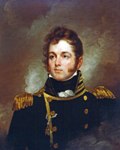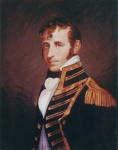-
 On this Day January 17th, 1781 Battle of Cowpens
On this Day January 17th, 1781 Battle of Cowpens
Ok so it is not a naval battle but a good morale boost for the US fleet!
Morgan's stratagem worked perfectly. The British drove in successive lines, anticipating victory only to encounter another, stronger line after exerting themselves and suffering casualties. The depth of the American lines gradually soaked up the shock of the British advance.
A few minutes before sunrise, Tarleton's van emerged from the woods in front of the American position. Tarleton ordered his dragoons to attack the first line of skirmishers, who opened fire and shot fifteen dragoons. The dragoons promptly retreated, whereupon Tarleton immediately ordered an infantry charge, without pausing to study the American deployment or to allow the rest of his infantry and his cavalry reserve to make it out of the woods. Tarleton attacked the skirmish line without pausing, deploying his main body and his two grasshopper cannon. The American skirmishers kept firing as they withdrew to join the second line manned by Pickens' militia. The British attacked again, this time reaching the militiamen, who (as ordered) poured two volleys into the enemy. The British—with 40% of their casualties being officers—were astonished and confused. They reformed and continued to advance. Tarleton ordered one of his officers, Ogilvie, to charge with some dragoons into the "defeated" Americans. His men moved forward in regular formation and were momentarily checked by the militia musket fire but continued to advance. Pickens' militia filed around the American left to the rear as planned after getting off their second volley.[51]
Taking the withdrawal of the first two lines as a full blown retreat, the British advanced headlong into the third and final line of disciplined regulars which awaited them on the hill. The 71st Highlanders were ordered to flank the American right. John Eager Howard spotted the flanking movement and ordered the Virginia militiamen manning the American right to turn and face the Scots. However, in the noise of battle Howard's order was misunderstood and the militiamen began to withdraw. It was now 7:45 am and the British had been fighting for nearly an hour. They were tired and disorganized, but they saw the militia withdrawing and believed the Americans were on the run. They charged, breaking formation and advancing in a chaotic mass. Morgan ordered a volley. Howard's militia stopped their withdrawal and made an about-face. The Virginians fired into the British at a range of no more than thirty yards, with deadly effect, causing the confused British to lurch to a halt. John Eager Howard then shouted "Charge bayonets!"[52]
The Continentals, as ordered, then mounted a bayonet charge. Tarleton's force, faced with a terrible surprise, began to collapse; some surrendering on the spot, while others turned and ran. Howard's men charged forward and seized the British cannons. Washington's cavalry came around from behind the American left to hit the British on their right flank and rear. Pickens' militia, having re-formed, charged out from behind the hill—completing a 360-degree circle around the American position—to hit the 71st Highlander Scots on the British left flank and rear. Howard ordered the Virginia militia, whose withdrawal had brought on the British charge, to turn about and attack the Scots from the other direction.
The shock of the sudden charge, coupled with the reappearance of the American militiamen on the left flank where Tarleton's exhausted men expected to see their own cavalry, proved too much for the British. Nearly half of the British and Loyalist infantrymen fell to the ground whether they were wounded or not. Their will to fight was gone. Historian Lawrence Babits diagnoses "combat shock" as the cause for this abrupt British collapse—the effects of exhaustion, hunger and demoralization suddenly catching up with them.[53] Caught in a clever double envelopment that has been compared with the Battle of Cannae,[54] many of the British surrendered. With Tarleton's right flank and center line collapsed, there remained only a minority of the 71st Highlanders who were still putting up a fight against part of Howard's line. Tarleton, realizing the desperate seriousness of what was occurring, rode back to his one remaining unit that was in one piece, the Legion Cavalry. He ordered them to charge, but they refused and fled the field.[55] The Highlanders, surrounded by militia and Continentals, surrendered. Desperate to save something, Tarleton managed to find about forty cavalrymen and with them tried to save the two cannons he had brought with him, but they had been taken. Tarleton with a few remaining horsemen rode back into the fight, but after clashing with Washington’s men, he too retreated from the field.[5] He was stopped by Colonel Washington, who attacked him with his saber, calling out, "Where is now the boasting Tarleton?". A Cornet of the 17th, Thomas Patterson, rode up to strike Washington but was shot by Washington's orderly trumpeter. Tarleton then shot Washington's horse from under him and fled, ending the battle.[56] It was 8 a.m. and the Battle of Cowpens had lasted approximately one hour.[5]
Excerpt from: http://en.wikipedia.org/wiki/Battle_of_Cowpens
-

And *that* is how one deals with the problems of Militia -- their inexperience, and their tendency to flee.
-

Link added to On This Day thread for 17 January.
 Posting Permissions
Posting Permissions
- You may not post new threads
- You may not post replies
- You may not post attachments
- You may not edit your posts
-
Forum Rules






 Reply With Quote
Reply With Quote




Bookmarks